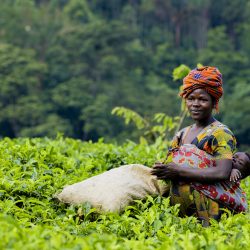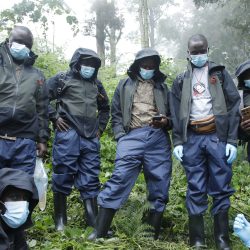Happy birth day to Susa mountain gorilla twins
Blog | 30/05/11
The news came out of the blue, in form of an SMS, mid-way up the hill to the Batwa Trail head in Mgahinga Gorilla National Park, Uganda – twin mountain gorillas were born in the Susa family group in Volcanoes National Park, Rwanda! This in itself is extraordinary, but that the news prompted a spontaneous collective singing of ‘Happy Birthday’ by a multinational contingency from DR Congo, Rwanda, and Uganda is just out of this world.
Rica Rwigamba, left, Head of Tourism and Conservation in the Rwanda Development Board shares the SMS announcement from her staff in the field with Sam Mwandha, Executive Secretary of the Greater Virunga Transboundary Collaboration.
Populations of the world’s remaining mountain gorillas, numbering around 780, exist in protected areas, or parks, that span international borders between DR Congo, Rwanda, and Uganda. That each country can come together and truly celebrate the birth of mountain gorillas in another country is really symbolic. You see, the response could very easily be groans from the other countries that also try to promote and market their own mountain gorilla tourism. But I witnessed none of that- just authentic rejoicing.
At the International Gorilla Conservation Programme, we look at everything in a regional context, even if the project that we are working on seems to be small in scope. The reality is that what happens in one country, both within and outside of the parks, affects the others.
The reason that this multinational contingency was hiking up that hill last Friday when the news came in, was to tour projects that were implemented under the umbrella of the Greater Virunga Transboundary Collaboration or GVTC.
The Batwa Trail in Mgahinga Gorilla National Park is one such project. Although the Trail is in cooperation with the Batwa living around MGNP, there are other Batwa settlements throughout the region and next to almost all protected areas in the Greater Virunga region.
This unique arrangement- where a cultural attraction is actually in the park- will be officially launched on June 7th and I’ll be writing more about this in the coming week. Coinciding with the launch will be the screening of a documentary on Batwa culture as well as The Batwa Trail that will be used throughout the region to highlight the unique, rich, and fragile culture of the Batwa people as well as elevate their social status.
Steven Barahirwa, a guide on The Batwa Trail discusses the Trail and the larger project with members of the GVTC.
Other projects and sites that were visited on this site include alternative energy projects, bamboo nursery and related bamboo handicraft cooperative, commercial complexes in Rwanda and Uganda, communal and household rainwater tank construction, and agricultural and beekeeping support projects. These projects were implemented by NGO partners of the protected areas and the GVTC, like IGCP in the case of household rainwater tanks construction, beekeeping, and The Batwa Trail.
What concluded this field visit within the three countries was a constructive meeting in which the members of the GVTC discussed the challenges faced in the field and identified projects appropriate for scaling up within the region. Like the good news that came in via SMS, there is collective ownership of what happens throughout the Greater Virunga landscape- both the good and the bad.
Pictures from other projects under the GVTC umbrella can be viewed from Flickr.




